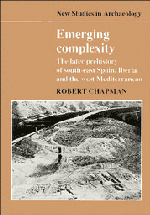Book contents
- Frontmatter
- Contents
- List of figures
- List of tables
- Preface
- 1 Two tribes: questions of theory, scale and explanation
- 2 Hello, goodbye: Iberian prehistory and traditional archaeology
- 3 Another one bites the dust: the implications of the absolute chronology
- 4 Getting better: south-east Spain, the cultural framework 5000–500 bc
- 5 Dancin' in the dark? Adaptation and intensification in south–east Spain
- 6 Centrefield: recent models of intensification and cultural change in south-east Spain
- 7 Into the groove: system scale and technological innovation in south-east Spain
- 8 Out of reach? Complexity, interaction and integration in south-east Spain
- 9 Eliminator: models and the archaeological record in south-east Spain
- 10 Strong persuader: intensification and interaction in Iberia and the west Mediterranean
- 11 With or without you: variability, evaluation and complexity
- Bibliography
- Index
4 - Getting better: south-east Spain, the cultural framework 5000–500 bc
Published online by Cambridge University Press: 05 March 2012
- Frontmatter
- Contents
- List of figures
- List of tables
- Preface
- 1 Two tribes: questions of theory, scale and explanation
- 2 Hello, goodbye: Iberian prehistory and traditional archaeology
- 3 Another one bites the dust: the implications of the absolute chronology
- 4 Getting better: south-east Spain, the cultural framework 5000–500 bc
- 5 Dancin' in the dark? Adaptation and intensification in south–east Spain
- 6 Centrefield: recent models of intensification and cultural change in south-east Spain
- 7 Into the groove: system scale and technological innovation in south-east Spain
- 8 Out of reach? Complexity, interaction and integration in south-east Spain
- 9 Eliminator: models and the archaeological record in south-east Spain
- 10 Strong persuader: intensification and interaction in Iberia and the west Mediterranean
- 11 With or without you: variability, evaluation and complexity
- Bibliography
- Index
Summary
As Binford has reminded us recently, our research should begin with the facts of the archaeological record and then move towards an interpretation of those facts (1983a). Our data are organised along the dimensions of time and space and predominantly by criteria of similarity and association. For European prehistorians from Childe to Clarke this organisation of the archaeological record has resulted in the creation of a hierarchy of entities, from attributes and types to assemblages, cultures, groups of cultures and technocomplexes (Childe 1956; Clarke 1968). As with all typological constructs, there has been debate over the utility and particularly the meaning of these entities. While north American scholars have concentrated attention on the validity of the type concept, European archaeologists have focused on the culture concept. Once the archaeological record had been organised into ‘cultures’, the interpretation of that record in terms of continuities and changes of ‘cultures’ could begin.
We have seen in chapter 2 that Iberian prehistoric cultures, like many others in Europe, were interpreted in a normative, ethnic framework. Recent debate has exposed the difficulties involved in this approach: it assumes that cultural similarity is a direct measure of human interaction; it obscures intra–cultural variability, for which an explanation is equally important; it involves methodological problems in defining cultural boundaries; and it assumes that the archaeological record is a ‘past tense’ of the ethnographic record.
- Type
- Chapter
- Information
- Emerging ComplexityThe Later Prehistory of South-East Spain, Iberia and the West Mediterranean, pp. 54 - 96Publisher: Cambridge University PressPrint publication year: 1990



